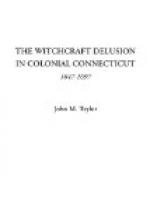“She brought diuers psons to the court that they might say something to cleere her, and much time was spent in hearing ym, but to little purpose, the grounds of suspition remaining full as strong as before and she found full of lying, wherfore the court declared vnto her that though the euidenc is not sufficient as yet to take away her life, yet the suspitions are cleere and many, wch she cannot by all the meanes she hath vsed, free herselfe from, therfore she must forbeare from goeing from house to house to give offenc, and cary it orderly in the family where she is, wch if she doe not, she will cause the court to comitt her to prison againe, & that she doe now presently vpon her freedom giue securitie for her good behauiour; and she did now before the court ingage fifty pound of her estate that is in Mr. Goodyeers hand, for her good behauior, wch is further to be cleered next court, when Mr. Goodyeare is at home.”
“She was suffered to dwell in the family of Thomas Johnson, where she continued till her death, October 9th, 1660.” (New Haven Town Records, Vol. ii, pp. 174,179.)
NATHANIEL AND REBECCA GREENSMITH
Nathaniel Greensmith lived in Hartford, south of the little river, in 1661-62, on a lot of about twenty acres, with a house and barn. He also had other holdings “neer Podunk,” and “on ye highway leading to Farmington.”
He was thrifty by divergent and economical methods, since he is credited in the records of the time with stealing a bushel and a half of wheat, of stealing a hoe, and of lying to the court, and of battery.
In one way or another he accumulated quite a property for those days, since the inventory of it filed in the Hartford Probate Office, January 25, 1662, after his execution, carried an appraisal of L137. l4s. 1_d_.—including “2 bibles,” “a sword,” “a resthead,” and a “drachm cup”—all indicating that Nathaniel judiciously mingled his theology and patriotism, his recreation and refreshment, with his everyday practical affairs and opportunities.
But he made one adventure that was most unprofitable. In an evil hour he took to wife Rebecca, relict of Abraham Elson, and also relict of Jarvis Mudge, and of whom so good a man as the Rev. John Whiting, minister of the First Church in Hartford—afterward first pastor of the Second Church—said that she was “a lewd, ignorant and considerably aged woman.”
This triple combination of personal qualities soon elicited the criticism and animosity of the community, and Nathaniel and Rebecca fell under the most fatal of all suspicions of that day, that of being possessed by the evil one.
Gossip and rumor about these unpopular neighbors culminated in a formal complaint, and December 30, 1662, at a court held at Hartford, both the Greensmiths were separately indicted in the same formal charge.
“Nathaniel Greensmith thou art here indicted by the name of Nathaniel Greensmith for not having the fear of God before thine eyes, thou hast entertained familiarity with Satan, the grand enemy of God and mankind—and by his help hast acted things in a preternatural way beyond human abilities in a natural course for which according to the law of God and the established law of this commonwealth thou deservest to die.”




